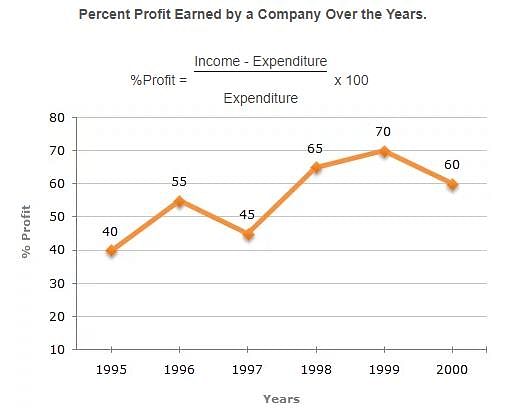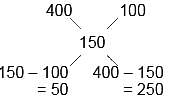Central Bank Apprentice Mock Test - 6 - Bank Exams MCQ
30 Questions MCQ Test - Central Bank Apprentice Mock Test - 6
How much tea, costing Rs. 400 per kg, should be added to 150 kg of tea costing Rs. 100 per kg so that the mixture be worth Rs. 150 per kg?
In a game of 100 points, A can give B 20 points and C 28 points. Then, B can give C:
| 1 Crore+ students have signed up on EduRev. Have you? Download the App |
Direction: The following line graph gives the annual percent profit earned by a Company during the period 1995 - 2000.

Q. If the profit in 1999 was ₹ 4 crores, what was the profit in 2000?

Direction : Two statements I and II are given. These statement may be either independent causes or may be effects of independent causes or a common cause. One of these statements may be the effect of the other statements. Read both the statements and decide which of the following answer choice correctly depicts the relationship between these two statements.
Mark answer :
I. There has been a high increase in the incidents of atrocities against women in the city during the past few months.
II. The police authority has been unable to nab the culprits who are committing crime against women.
Direction: Study the following instructions carefully and then answer the questions that follow.
In making decisions about important questions it is desirable that a candidate is able to distinguish between 'strong' and 'weak' arguments so far as they relate to the questions.
'Weak' arguments may not be directly related to the questions and may be of minor importance or may be related to the trivial aspect of the question.
Each question below is followed by two arguments I and II. You have to decide which of the arguments is a 'strong' argument and which is a 'weak' argument.
Statement: Should cottage industries be encouraged in rural areas?
Arguments:
(I) Yes, rural people are creative.
(II) Yes, this would help to solve the problem of unemployment to some extent.
Direction: In each question below is given a statement followed by two assumption numbered I and II. An assumption is something supposed or taken for granted. You have to consider the statement and the following assumption and decide which of the assumption is implicit in the statement.
Statement:
We grew up in joint families, which meant less space for the individual.
Assumptions:
I. Big houses were unknown in the past.
II. One has to make much adjustment in a joint family.
Direction: Read the following passage carefully and answer the questions. Your answer to these questions should be based on passage only.
Mandela recollects that it was almost impossible for a black man in south Africa to fulfill his obligation to his family and society because of the system of apartheid practiced by the white rulers. He began to hanker after freedom when he realized that his freedom had been taken away from him when he reached manhood. He yearned for the basic and honorable freedoms of achieving his potential, of marrying, having a family-the freedom not to be obstructed in a lawful life. When Mandela realized that not only his freedom was curtailed, but the freedom of everyone who looked like him was also curtailed. That's when he joined the African national Congress and that is when the hunger for his own freedom became the greater hunger for the freedom of his people.
Q. What was the realization of Mandela?
Direction: Read the following passage carefully and answer the questions. Your answer to these questions should be based on passage only.
Mandela recollects that it was almost impossible for a black man in south Africa to fulfill his obligation to his family and society because of the system of apartheid practiced by the white rulers. He began to hanker after freedom when he realized that his freedom had been taken away from him when he reached manhood. He yearned for the basic and honorable freedoms of achieving his potential, of marrying, having a family-the freedom not to be obstructed in a lawful life. When Mandela realized that not only his freedom was curtailed, but the freedom of everyone who looked like him was also curtailed. That's when he joined the African national Congress and that is when the hunger for his own freedom became the greater hunger for the freedom of his people.
Q. Whose concern does this passage voice?
What is the typical method of disbursement for a loan used to purchase a vehicle ?





















